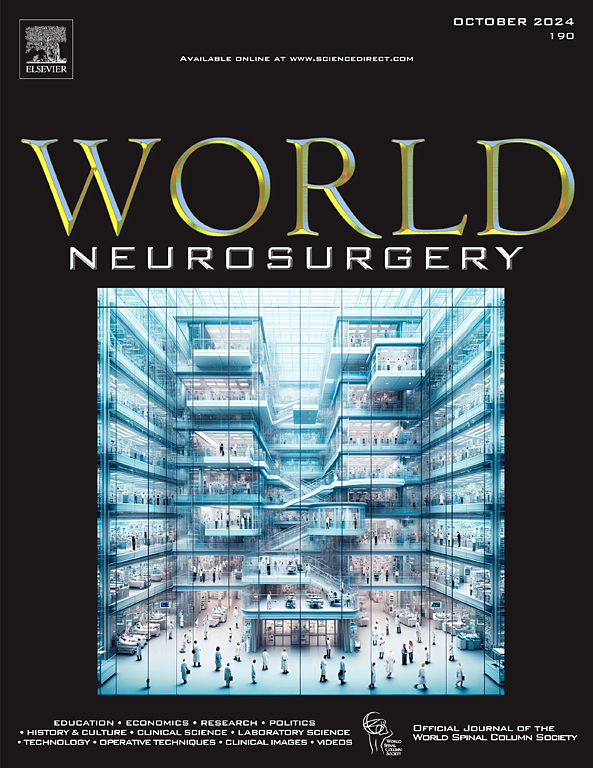Should Proximal Fixation be at C2 or C3-C4? An Application of the Operative Value Index for Elective Posterior Cervical Decompression and Fusion
IF 1.9
4区 医学
Q3 CLINICAL NEUROLOGY
引用次数: 0
Abstract
Background
There is clinical equipoise regarding the ideal upper instrumented vertebrae (UIV) for elective posterior cervical decompression and fusion (PCDF). Instrumentation may be performed at the axial C2 level, or at the subaxial C3/C4 vertebrae. To our knowledge, a true “value” (outcomes per dollar spent) comparison axial versus subaxial UIV for PCDF has never been performed.
Methods
We retrospectively identified 275 long-segment (≥3-levels fused) PCDFs with available Neck Disability Index (NDI) scores at baseline and at 3 months postoperatively. C2 UIV (n = 67) was compared to C3/C4 UIV (n = 208). Time-driven activity-based costing was applied to identify the true intraoperative costs for each case. The Operative Value Index (OVI) was defined as the percent improvement in NDI score from baseline, per $1000 spent intraoperatively. Multivariable regression analysis was performed to compare intraoperative costs and OVI between C2 and C3/C4 UIV.
Results
The average total cost of a C2 construct was $13,751 ($5247), compared with $10,778 ($2237) for C3/C4 (P < 0.001). Forty percent of C2 cases and 32% of C3/C4 cases, respectively, achieved clinically significant improvement in NDI. On multivariable regression analysis, C2 UIV was associated with significantly higher total cost (beta-coefficient: $1814 ± 553, P = 0.001), supply cost (beta-coefficient: $1185 ± $482, P = 0.015) and personnel cost (beta-coefficient: $275 ± $116, P = 0.019). However, there was no significant difference in OVI (P = 0.155) between C2 and C3/C4 UIV.
Conclusions
Although the C2 UIV construct incurred significantly higher intraoperative costs compared with C3/C4 UIV, there was no significant difference in “value” between axial and subaxial UIV.
近端固定在C2还是C3-C4?择期颈椎后路减压融合手术价值指数的应用。
介绍:择期颈椎后路减压融合(PCDF)的理想上固定椎体(UIV)有临床平衡。内固定可在C2轴位或下C3/C4椎体进行。据我们所知,从未对PCDF的轴向和亚轴向紫外线进行过真正的“价值”(每美元花费的结果)比较。方法:我们回顾性地确定了275个长节段(≥3节段融合)pcdf,在基线和术后3个月有可用的颈部残疾指数(NDI)评分。C2 /C4组(n=208)与C2 /C4组(n=67)比较。采用时间驱动的作业成本法(TDABC)来确定每个病例的真实术中成本。手术价值指数(OVI)定义为术中每花费1000美元,NDI评分较基线改善的百分比。采用多变量回归分析比较C2和C3/C4 ivv的术中成本和OVI。结果:C2假体的平均总成本为13,751美元(5,247美元),而C3/C4假体的平均总成本为10,778美元(2,237美元)。结论:尽管C2假体的术中成本明显高于C3/C4假体,但轴向和亚轴向假体的“价值”没有显著差异。
本文章由计算机程序翻译,如有差异,请以英文原文为准。
求助全文
约1分钟内获得全文
求助全文
来源期刊

World neurosurgery
CLINICAL NEUROLOGY-SURGERY
CiteScore
3.90
自引率
15.00%
发文量
1765
审稿时长
47 days
期刊介绍:
World Neurosurgery has an open access mirror journal World Neurosurgery: X, sharing the same aims and scope, editorial team, submission system and rigorous peer review.
The journal''s mission is to:
-To provide a first-class international forum and a 2-way conduit for dialogue that is relevant to neurosurgeons and providers who care for neurosurgery patients. The categories of the exchanged information include clinical and basic science, as well as global information that provide social, political, educational, economic, cultural or societal insights and knowledge that are of significance and relevance to worldwide neurosurgery patient care.
-To act as a primary intellectual catalyst for the stimulation of creativity, the creation of new knowledge, and the enhancement of quality neurosurgical care worldwide.
-To provide a forum for communication that enriches the lives of all neurosurgeons and their colleagues; and, in so doing, enriches the lives of their patients.
Topics to be addressed in World Neurosurgery include: EDUCATION, ECONOMICS, RESEARCH, POLITICS, HISTORY, CULTURE, CLINICAL SCIENCE, LABORATORY SCIENCE, TECHNOLOGY, OPERATIVE TECHNIQUES, CLINICAL IMAGES, VIDEOS
 求助内容:
求助内容: 应助结果提醒方式:
应助结果提醒方式:


